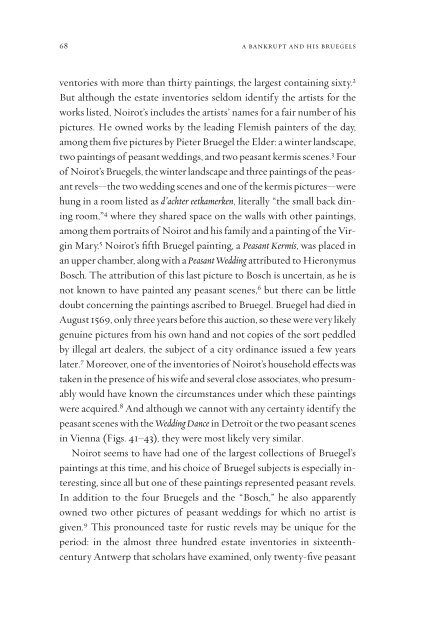Pieter Bruegel and the Art of Laughter - AAAARG.ORG
Pieter Bruegel and the Art of Laughter - AAAARG.ORG
Pieter Bruegel and the Art of Laughter - AAAARG.ORG
You also want an ePaper? Increase the reach of your titles
YUMPU automatically turns print PDFs into web optimized ePapers that Google loves.
68 a bankrupt <strong>and</strong> his bruegels<br />
ventories with more than thirty paintings, <strong>the</strong> largest containing sixty. 2<br />
But although <strong>the</strong> estate inventories seldom identify <strong>the</strong> artists for <strong>the</strong><br />
works listed, Noirot’s includes <strong>the</strong> artists’ names for a fair number <strong>of</strong> his<br />
pictures. He owned works by <strong>the</strong> leading Flemish painters <strong>of</strong> <strong>the</strong> day,<br />
among <strong>the</strong>m five pictures by <strong>Pieter</strong> <strong>Bruegel</strong> <strong>the</strong> Elder: a winter l<strong>and</strong>scape,<br />
two paintings <strong>of</strong> peasant weddings, <strong>and</strong> two peasant kermis scenes. 3 Four<br />
<strong>of</strong> Noirot’s <strong>Bruegel</strong>s, <strong>the</strong> winter l<strong>and</strong>scape <strong>and</strong> three paintings <strong>of</strong> <strong>the</strong> peasant<br />
revels—<strong>the</strong> two wedding scenes <strong>and</strong> one <strong>of</strong> <strong>the</strong> kermis pictures—were<br />
hung in a room listed as d’achter eetkamerken, literally “<strong>the</strong> small back dining<br />
room,” 4 where <strong>the</strong>y shared space on <strong>the</strong> walls with o<strong>the</strong>r paintings,<br />
among <strong>the</strong>m portraits <strong>of</strong> Noirot <strong>and</strong> his family <strong>and</strong> a painting <strong>of</strong> <strong>the</strong> Virgin<br />
Mary. 5 Noirot’s fifth <strong>Bruegel</strong> painting, a Peasant Kermis, was placed in<br />
an upper chamber, along with a Peasant Wedding attributed to Hieronymus<br />
Bosch. The attribution <strong>of</strong> this last picture to Bosch is uncertain, as he is<br />
not known to have painted any peasant scenes, 6 but <strong>the</strong>re can be little<br />
doubt concerning <strong>the</strong> paintings ascribed to <strong>Bruegel</strong>. <strong>Bruegel</strong> had died in<br />
August 1569, only three years before this auction, so <strong>the</strong>se were very likely<br />
genuine pictures from his own h<strong>and</strong> <strong>and</strong> not copies <strong>of</strong> <strong>the</strong> sort peddled<br />
by illegal art dealers, <strong>the</strong> subject <strong>of</strong> a city ordinance issued a few years<br />
later. 7 Moreover, one <strong>of</strong> <strong>the</strong> inventories <strong>of</strong> Noirot’s household eªects was<br />
taken in <strong>the</strong> presence <strong>of</strong> his wife <strong>and</strong> several close associates, who presumably<br />
would have known <strong>the</strong> circumstances under which <strong>the</strong>se paintings<br />
were acquired. 8 And although we cannot with any certainty identify <strong>the</strong><br />
peasant scenes with <strong>the</strong> Wedding Dance in Detroit or <strong>the</strong> two peasant scenes<br />
in Vienna (Figs. 41–43), <strong>the</strong>y were most likely very similar.<br />
Noirot seems to have had one <strong>of</strong> <strong>the</strong> largest collections <strong>of</strong> <strong>Bruegel</strong>’s<br />
paintings at this time, <strong>and</strong> his choice <strong>of</strong> <strong>Bruegel</strong> subjects is especially interesting,<br />
since all but one <strong>of</strong> <strong>the</strong>se paintings represented peasant revels.<br />
In addition to <strong>the</strong> four <strong>Bruegel</strong>s <strong>and</strong> <strong>the</strong> “Bosch,” he also apparently<br />
owned two o<strong>the</strong>r pictures <strong>of</strong> peasant weddings for which no artist is<br />
given. 9 This pronounced taste for rustic revels may be unique for <strong>the</strong><br />
period: in <strong>the</strong> almost three hundred estate inventories in sixteenthcentury<br />
Antwerp that scholars have examined, only twenty-five peasant












